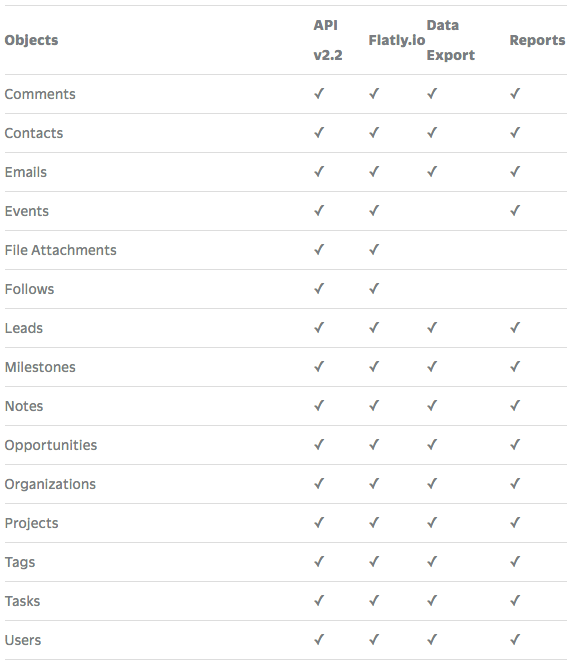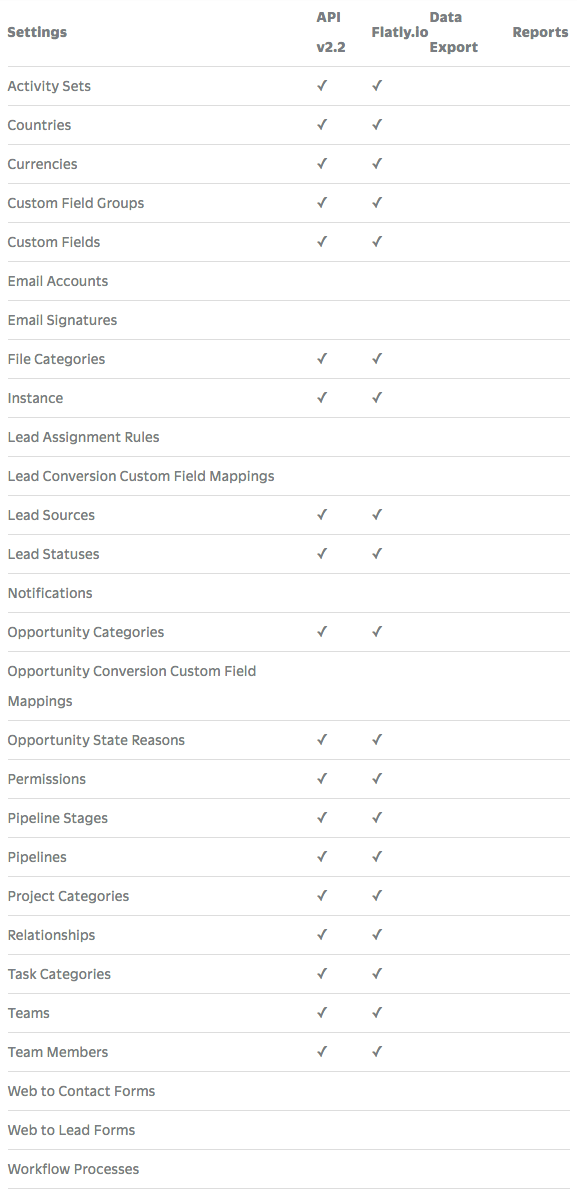The post 4 questions to help you ensure your mobile CRM’s security appeared first on Insightly.
]]>In today’s business environment, where more people are working remote than ever before, businesses need a way to centralize customer data and make it accessible on the go, from anywhere. For nearly every company, this means a CRM platform with a mobile app.
According to a recent Mobile CRM Market report by Future Market Insights, modern businesses are placing customer satisfaction at the top of their priority list and are actively seeking fine-grained insights for their sales realms to access on the go. This, in turn, is preparing the grounds for high-scale adoption of mobile CRM platforms across the globe through 2029.

While accessibility from any device at any time is a powerful advantage, it requires added security to protect the valuable information housed in your CRM. When properly managed, CRM data is an important asset to your business. So as you consider introducing mobile CRM use to your team’s daily tech stack, make sure both your CRM provider and your team understand and meet data security and customer data privacy standards. It’s important to your customers and it should be important to you.
Here are the top four mobile security questions to ask your CRM provider.

1. How do you manage mobile CRM security?
Start with the basics. Make sure your CRM uses the same high security standards across all applications, including mobile. Check to see if your CRM has been independently assessed for compliance to SOC 2 Type 2 for secure data management and customer privacy. Double-check the company’s compliance with EU-U.S. Privacy Shield and the General Date Protection Regulation (GDPR).

2. Is there an option for custom user permissions?
This may seem pretty straightforward at first, but access is about more than just the number of users on your platform. If your CRM provider uses unified endpoint security solutions, then you’ll be able to control user permissions and role-based access to CRM data consistently across all devices. It’s great to bring cross-functional teams together using a single source of truth on customer data, but not every person in your organization needs access to all of the details of every account and project. Make sure your mobile CRM app can capture different user roles with the added security, so that each role only sees the information that is relevant to their work.

3. What are ongoing proactive security measures?
While adherence to established data management and customer privacy standards is non-negotiable, you want a CRM provider to continuously improve overall security rather than just respond to malicious threats. If you are in a highly regulated vertical, like finance or healthcare, you may need custom security solutions and ongoing maintenance.

4. Are there any safeguards against employee oversight?
While a mobile CRM offers freedom, convenience, and speed, it comes with certain risks. Your mobile CRM can be used as an entry point into your core CRM system. Phones and tablets get stolen or lost. So in addition to user permissions management, double-check that your mobile CRM has robust user authentication and end-to-end encryption. On your part, include mobile CRM usage best practices in your internal customer data management and user guidelines.
Depending on your industry, you may need a CRM provider with custom security solutions. There are also a few auxiliary things to consider, such as user interface (UI) and integrations, that can impact a mobile CRM’s security. Even though modern CRMs are able to balance user interface with security measures without sacrificing the quality of either, make sure that your mobile CRM app was designed for security, not just to please the eye.
It takes a lot to keep data safe, secure, and accurate. It takes only one data leak or data breach to ruin a company’s reputation and hard-earned trust with the customer. Take your mobile CRM security seriously and you’ll set up your team and business for long-term success.
Read more like this:
- What is data integrity? How to achieve it?
- What are different types of customer data?
- How to organize customer data in a CRM
The post 4 questions to help you ensure your mobile CRM’s security appeared first on Insightly.
]]>The post Engineered from the ground up appeared first on Insightly.
]]>Often in the typical life journey of a startup, it all starts with a prototype and a burst of early adopters, who are your only customer base. This initial success is enough to light up the founders to do whatever it takes to showcase and validate the product-market fit, a crucial ingredient for venture funding and future growth. It is also a phase when things are engineered for survival. The feature definitions are flexible and malleable, the use cases are primarily driven by the willing customers for the next big deal or growth spurt (assuming they are strategically aligned, of course).
Insightly is no different. We went through some similar phases of growth. We built features with a fervor. We understood and fulfilled the needs of the small and medium businesses. However, once we were outside the initial survival phase, we were very prudent about how we built our application.
Though it was difficult, we took a needed pause to evaluate our strategy for architecture and growth. Based on where we wanted to be, we made many product decisions coupled with some key architectural decisions that changed the overall DNA and trajectory of our offerings. From our founder, who wrote most of the initial code, to the early team that built many of its subsequent offerings, Insightly has always been grounded on a solid engineering foundation. This foundation is the lifeline of our company and has been a catalyst that has helped us grow exponentially.
Here are some of the engineering and architectural initiatives that not only helped us deliver compelling functionalities to our customers, but also formed the rock-solid foundation of Insightly’s SaaS offering.

Metadata driven architecture (MDA)
From early days, when we were working on our long-term product strategy and roadmap, it became very clear that we needed an architecture that could serve us for the long term and yet be flexible enough to accommodate the heterogeneous needs of our growing customer base. Being a horizontal CRM product that caters to a multitude of verticals, MDA provided the needed flexibility. By abstracting the functionality from the application architecture, we were not only able to personalize the experience tailored to each of our users, but it was also easily maintainable and less prone to errors and regressions. Converging the metadata and their instance data in real time and dynamically rendering the user Interface at runtime, helped us hit the mark with our customers.
Custom objects & custom fields
Custom Objects and Custom Fields have an equal footing as the pre-defined standard objects, that comes out of the box from Insightly. From CRUD operations to reporting, from extensibility using custom fields to API access for these Objects, they thrive and live like first class citizens within the Insightly ecosystem. The MDA architecture underneath helps us provide a consistent user experience across all the objects within Insightly.
Microservices
Decoupling many of our heavy lifting modules into smaller asynchronous jobs not only helped us reach our high availability goals, but also helped us to scale exponentially and handle many more requests. It also provided the required elasticity to scale individual pieces of our software based on the statistics and monitoring we had in place. We were able to surgically fix issues that helped us in our overall performance, stability, and at the end of the day, improve on the one metric that counts the most, usability of our product and customer experience!
Platform
At Insightly, a platform strategy was always at the core of our architecture and roadmap. In addition to providing our customers with a myriad of powerful CRM features, we also wanted to extend our value creation by building meaningful extensions and integrations. Insightly provides a rich set of Restful APIs that can be used by external ecosystems to create more value to our end customers. We also allow folks to extend the capabilities by providing a seamless integration with an external serverless compute framework from within our application ecosystem.
Security
Security is at the core of any organization that manages its customer data, and Insightly is no exception. Security is at the heart of everything we do and work on at Insightly. From a company wide initiative to be SOC2 Type II compliant, to many other initiatives like GDPR, Australian Privacy Act, and Privacy Shield, we always adhere to current industry standards and security practices. We constantly audit our applications for vulnerabilities and keep plugging away any vulnerabilities we find. From a A+ rating on our SSL server tests, to adopting best coding practices, from internal security checks to external audits, from to Pen testings to OWASP initiatives, security is embedded at all levels of our technology spectrum.

SSL Server Test Results
Simplicity
Keep it simple! It has been a mantra our engineers have always relied upon, and it has helped us grow as an engineering organization. While we have tackled some hard engineering problems related to architecture and scale, we have always brainstormed ourselves out of complex solutions, and relied upon sound, simple and elegant solutions that deliver the end results for us and our customers.
Mobile
In the current era, mobile apps are not just “nice to have”, but are an essential part of any offering. At Insightly, we built our mobile app from the ground up using some of the latest technologies. Rather than trying to mimic the exact web user behavior, we focused on ensuring the mobile use cases were at the forefront of our design and architecture. From beautiful and polished UI to handling push notifications, from stability to performance, we wanted the user experience to be nothing but amazing!
Build versus rent
Sometimes you do not have to build everything from the ground up. It is prudent to integrate with some best of breed to provide meaningful and seamless experience to your customers. For example, we integrate with some of the best cloud companies that are the leaders in sending millions of email or managing your queues at scale, or helping you monitor the health of your applications and servers.

Engineered by engineers
Finally, the Insightly Web Application is not a standard monolithic legacy application. It’s a 21st century, enterprise grade, cloud based SaaS application built not only with the latest technologies, trends and practices, but also by some of the brightest and smartest engineers that take personal pride in how they have engineered and architected the solution. They collaboratively and consistently balance innovation and customer needs every day. In the end, it’s the engineers and the culture of our entire organization that is the true rock solid foundation of all our offerings.
The post Engineered from the ground up appeared first on Insightly.
]]>The post Managing data: Top 3 roadblocks to effective data use (Part 2) appeared first on Insightly.
]]>Managing data: Why customer data is increasingly important (Part 1)
Managing data: How to accelerate revenue growth with data (Part 3)
As covered in the first post of the effective data use series, companies across all industries are increasingly motivated to leverage customer data.
Despite data’s importance, effectively using it can be complicated—especially for midsize companies that lack the resources of larger enterprises.
Today we’ll explore three common roadblocks to effective data use and how technology is leveling the playing field for midsize companies. We’ll also look at Insightly customers who have managed to overcome these common roadblocks.
1. Growth rate that outpaces existing IT infrastructure
“Our 5-year plan calls for 3X growth in our customer count and top-line performance.”
On paper, this type of statement sure sounds great. After all, who doesn’t want to experience rapid growth? While rapid growth can be a very good thing, growing too fast can have unintended consequences — especially on a company’s IT infrastructure.
Here are two high-growth companies, Insightly customers, that achieved the best of both worlds by adopting a CRM that could keep pace with expansion.


4over, LLC overcomes data roadblocks by centralizing all of its customer relationship data into a searchable ecosystem.
With a local presence in more than 100 geographic markets, 4over is respected as one of North America’s premier wholesale print companies. The company sells a number of different printed products through a network of third party resellers, marketing firms, and graphic designers.
With an ever-increasing amount of relationship, project, and pipeline data flowing into the company, 4over’s existing infrastructure could no longer support its growth trajectory.
“We’ve grown into a medium-sized organization and needed a more efficient way to track customer information beyond simple spreadsheets,” says Rita Ward, Overseer of Outbound Telesales at 4over. “We needed a reliable way to track who was working on what in real-time to avoid missed deadlines and miscommunication.”
By centralizing all of its customer information into a searchable, cloud-based CRM system, 4over has elevated its record keeping across the entire organization. Telesales, for example, tracks conversations with prospective customers, enabling the team to increase the effectiveness of outreach campaigns. Business development reps use the CRM to capture key correspondence and emails from any web-enabled device, streamlining customer engagement efforts and accelerating growth.
Continue reading about 4over’s success story.
Annexus Health overcomes data roadblocks by focusing on currency and recency of pipeline intelligence.
Research from the National Cancer Institute estimates that more than 1.7 million Americans were diagnosed with cancer in 2018, leaving many families in desperate need of affordable cancer care. The assistPoint platform, from Annexus Health, is a web-based software application that simplifies the process of matching patients to financial and nursing support programs.
With 250+ cancer centers already using assistPoint and thousands more in the pipeline, Annexus Health reached a pivotal point in its data management journey.
“We’re working with hundreds of cancer center organizations, each of which has multiple points of contact along with countless other data points,” says Kerry Bradley, Co-Founder of Annexus Health. “As the organization advances in its use of assistPoint, the number of linked contacts and interactions with each organization increases.”
Adopting a CRM that provides out-of-the-box integrations to other vital business systems has allowed Annexus Health to manage a rapidly expanding contact list without encountering stale data. “Google Docs, Microsoft OneDrive, and Power BI are some of the integrations we rely on,” says Bradley.
An integration to the company’s support ticketing software feeds real-time customer service data into the CRM without manual effort. “This keeps everyone in the loop, and it helps us avoid data silos in our business,” says Bradley.
Learn how Annexus Health is leveraging data to serve more cancer centers.
2. Disintegrated systems
Companies don’t typically intend to create data silos. In most cases, they form organically over long periods of time. In today’s marketplace of countless SaaS tools, there’s an app for just about every need. Each newly deployed tool brings incremental efficiency, but, without attention to system design, it can also lead to massive datasets that few users know about.
Let’s explore how two midsize companies solved the disintegration trap.
The Red Pen overcomes data roadblocks by tracking the student journey in a centralized source of truth.
Since 2011, more than 2,400 students from across the globe have trusted The Red Pen’s mentoring services. The company’s impressive track record makes it the go-to educational consulting firm for students hoping to study abroad.
With a world of students to serve, The Red Pen needed a better way to collect, organize, and track student relationship information.
“We had a lot of data, but we didn’t have an efficient way to organize it,” says Namita Mehta, Partner at The Red Pen.
Moving to a centralized customer database to track each student interaction eliminates confusion and delivers much-needed transparency to the team. Integrated inboxes combined with web-to-lead forms accelerate the organization’s ability to collect more student engagement data with less effort.
As students advance through the pipeline, won opportunities are converted into projects within the organization’s CRM, preserving a historical record of each relationship and eliminating the need for overlapping business systems. “Notes and emails stay intact throughout the entire customer journey,” says Mehta.
Continue reading about how The Red Pen harnesses data to engage more students.


Skidmore Group overcomes data roadblocks by gaining user adoption.
With a corporate history dating back to 1946, the Skidmore Group has evolved into a diversified holding firm that has built more than twenty successful brands.
Kitchen Art Design, one of the companies in Skidmore Group’s portfolio, needed a way to overcome scattered customer, project, and pipeline data.
“Customer information was spread across folders, handwritten notes, and inboxes. This made it difficult to understand customers and communicate with them,” says Rody van Vianen, Manager of Business Improvement at Skidmore Group.
To ensure a long-term solution to the problem, the team needed a CRM that was intuitive for a wide spectrum of users. “Our main consideration was ease of use,” says van Vianen.
Selecting an easy-to-use CRM has led to a strong adoption rate, better data, and fewer silos. Design consultants were the first group to adopt the CRM for enhanced sales pipeline management. Back office staff and production teams also use the system to track important details, such as customer payment and on-time delivery.
Implementing an intuitive CRM has delivered so much efficiency for Kitchen Art Design that the Skidmore Group now uses it to track investment opportunities, deals, and other information at the parent company level.
Learn more about Skidmore Group’s approach to data management.
3. Cumbersome legacy CRMs
A quick web search returns dozens of CRM products. Comparing the many features, benefits, and pricing levels can be overwhelming, leading some companies to base their decisions purely on brand recognition. While name recognition is one factor to consider, it’s not everything. More important is the CRM’s ability to adapt to your specific business model.
Here’s how DynEd and O2X improved their business processes by switching CRMs.
DynEd overcomes data roadblocks by implementing manageable CRM processes.
An impressive 25 million students have learned English by using software from DynEd International, Inc. The company’s approach incorporates a unique blend of AI-powered technology, tutors, and internationally recognized testing standards.
With millions of records to keep organized from customers, educational institutions, and business partners, the company’s legacy CRM had become unmanageable.
“Customer information would regularly be incomplete, which impacted the sales process,” says Edda Cortez, Lead Americas Sales Administrator at DynEd. A major cause of friction was the CRM’s clunky and complicated conversion workflow, which caused many team members to abandon the system altogether.
Migrating to an intuitive, easily customizable CRM has allowed DynEd to scale its sales processes. For starters, the team built highly customized, multi-stage pipelines to align with its exact sales management workflow. Reports and dashboards provide additional clarity to the deal tracking process.
“Once opportunities advance to a certain stage in the pipeline, there’s a stronger likelihood that the deal will close,” says Cortez. “This allows us to build more reliable forecasts and make smarter business decisions.”
Read more about how DynEd scaled its sales processes.


O2X overcomes data roadblocks with workflow automation
O2X is at the forefront of human performance education. With a client list that includes the US Navy, FBI, State Department, and many police and fire departments, O2X is known for elevating the performance of tactical athletes.
Seeking to elevate the efficiency of its own business processes, the O2X team needed to overcome its legacy CRM’s shortcomings.
“The system’s limited functionality did not meet our needs, which explained why so few of us actually used it,” says John Hall, Operations Manager at O2X.
The team switched to Insightly CRM, which made an immediate impact on productivity. Inbox integration, in particular, saved the team countless hours of manual data entry.
“The Insightly Sidebar allows users to quickly save contacts and correspondence without leaving their inboxes,” says Hall.
Workflow automation delivers additional efficiency, eliminating time-intensive administrative tasks. “Workflow rules, activity sets, tasks, email notifications, and project pipelines keep everything on track,” says Hall.
See how O2X uses workflow automation for other processes.
Next up, accelerating growth with data
The next, and final, article in this series will spotlight innovative ways that medium-size companies harness data to accelerate revenue growth, boost profits, and solidify customer loyalty.
As always, be sure to check out Insightly’s collection of customer stories.
The post Managing data: Top 3 roadblocks to effective data use (Part 2) appeared first on Insightly.
]]>The post Top CRM best practices: data integrity appeared first on Insightly.
]]>Part 1: Backup & security
Part 3: User adoption
Dealing with duplicate data in a CRM
According to a 2015-2016 survey report from Experian Data Quality, “Duplicate data, in particular, jumped from 32 to 51 percent.” This is hardly a surprise due to the rapid growth of data, nonetheless it is a serious problem for many organizations, contributing to a poor customer experience, decreased efficiency, and misinformed decisions.
Insightly already detects duplicates when creating or importing new records, but sometimes these duplicate records sneak into your CRM usually because of human error, lack of internal resources, poorly implemented software, and even user permissions (see User Permissions).
5 ways to deduplicate records in Insightly
- Smart Merge is an Insightly feature that finds duplicates with similar sounding or spelling of names, and gives you a thorough way of merging all related record objects for contact, lead, and organization records.
- Dedupely integrates with Insightly to find duplicates for almost all your major record types using a variety of criteria customizable to you, and optionally, offers automatic duplicate merging.
- Look to standalone data utilities like Excel for a complete duplicate scan. This may require programming to build a deduplication algorithm for your organization and to get your data into the tool for analysis (see Version History & Backups). Once you have identified your potential duplicates, manually merge your Project, Opportunity or Task records. SmartMerge will do a fantastic job at taking care of the rest!
- The Deduplication Insight Card within Insightly automatically detects a duplicate within open lead records and displays an in-product alert showing the matching duplicates.
- Insightly’s new AWS Lambda functionality lets you create a function to run a deduplicate check against all record types within Insightly. If it detects an email match, Insightly will flag that record as a duplicate.
Here is a chart showing the available features, record types, and related record objects from each tool:

(Click here for more up-to-date information)
As you can see we have a great set of tools to deduplicate records! However, this is not enough. We need to setup best practices and processes for decreasing the creation of duplicates and increasing the accuracy of matching more potential duplicates.
General best practices for data management include:
Train users to develop good habits for avoiding duplicates when creating or importing new records. When using Insightly CRM mobile, Gmail or Outlook Sidebar, use the search feature before adding a new record as the duplicate detection feature is only available on the web version.
Create data entry rules and train your users how to enter in data using the correct format. Insightly does not offer customizable required fields or validation rules, so try to use custom drop down menus instead of free text fields. When users accidentally enter the wrong format, you can update your data to the correct format using Zapier’s Formatter App, Insightly’s Workflow Automation feature, or manually using the bulk edit or bulk update import tools.
Get up-to-date information. Here are three ways to get this valuable information into your database:
Contact update form
Get information straight from the customer whether in-person, over the phone, or via email. This is hands down the most accurate way to get up-to-date information.
You can automate this process by creating a Zapier integration for Mailchimp and Insightly. Mailchimp’s Update Profile Link allows subscribers to update their contact information and preferences. When subscribers update their profile, Zapier updates your contacts in Insightly with the new information. Watch my CRM Contact Profile Update Form Integration Tutorial.
Profile enrichment tools
These tools enrich your data by validating and pairing your contact records with relevant information online using sources like social media profiles, company websites, list provider databases, and even from your email client. Collecting data that is updated often, such as email signatures, is going to be the next best way to get up-to-date information
Use Evercontact to automatically scan email signatures from your Office 365 Outlook or Gmail email client. Then let PieSync handle the rest by synchronizing any updated contact records with Insightly. I recommend reading, The Ultimate Guide to Outlook People By Piesync.
The next best integration for data enrichment is to integrate with a tool like Clearbit. With Clearbit’s Zapier integration you can automatically enrich Lead, Contact & Organization records with relevant information compiled from hundreds of data sources. This will help keep your data accurate and updated. Watch my CRM Contact Profile Enrichment Integration Tutorial
Manual updates
Many businesses have forms and documents stacked away that have yet to be transcribed into the database… Create custom filtered list views to find incomplete records and request the record owner to manually update the missing fields. This can be processed more efficiently with the use of the bulk edit and bulk update importtools.
- Find patterns in your data and fill in the blanks. This is especially effective for email addresses.
For example, if all of an organization’s email addresses are in this format “[email protected]”, we can make an educated guess and apply this format to all other contacts in that organization with missing email addresses.
- Never delete data. You may have incomplete records, but it is likely the data is of value to your organization and may be completed in the future.
- Enforce your data entry rules for any data source integrated with Insightly such as list providers or software integrations. When creating new records in Insightly check for duplicates first. If the record is a duplicate, you will need to update the record instead of creating a new one.
In addition, multiple software integrations may result in duplicates because the integrations do not always play nice together. Try creating one workflow automation process or software integration at a time.
Measure, revise, and repeat
- Create a standard operating procedure for finding duplicates and merging records. You can start by asking the right questions such as:
- What fields in our database hold information related to the record’s identity i.e. name, email address, phone number, etc.?
- Do we need to “normalise” all those fields before checking for duplicates?
- Will analyzing those fields allow us to find more potential duplicate records?
- Can we use third party tools to scan our database for potential duplicates?
- Do we need a full duplication analysis report?
- How do we identify the “winning” record?
- What data will be transferred to the “winning” record?
- What leftover data do we need to save from the “loser” record(s)?
- How do we manage lost links and objects after merging records?
- Is manual or automatic merging the best option for our organization?
- Backup your data before and after each duplicate merge. If you are using Dedupely’s Automatic Merging tool, then look at backing up your data every ten minutes with Flatly.io (see Version History & Backups).
- Monitor your deduplication analysis reports. Identify what record types have the largest duplicate rate and which fields are often incomplete. With the right business intelligence, you can find the source of those duplicates. Then you can create a resolution to revise your software solution, training material, and data entry rules.
- Clean your database often.
Action Plan
Take the time to plan an effective data management strategy and procedure for cleaning your database. By doing so, you will allow for a better customer experience, increased efficiency, and more informed decisions.
Go to the Best Practices & Discussions forum in the Insightly Community, where I posted the CRM Best Practices for Insightly Worksheet. This post has everything you need to setup your best practices in Insightly along with more helpful tips to secure your CRM investment.
After implementing these best practices for your organization, I encourage you to leave feedback in the Insightly Community. With your help, my fellow Insightly Heroes and I can continuously improve the best practices for all Insightly users.
Stay tuned for Part 3 of “5 Best Practices for Insightly CRM” where we provide more helpful tips on dashboard reporting.
To be continued…
The post Top CRM best practices: data integrity appeared first on Insightly.
]]>The post Top CRM best practices: backup & security appeared first on Insightly.
]]>Part 2: Data integrity
Part 3: User adoption
Data integrity is key to a good CRM user experience.
Insightly continues to go the extra mile to build product features designed around data security, protection and permissions.
Significant Insightly CRM updates (2016-2017):
- SOC2 Type 2 compliant
- EU-U.S. Privacy Shield compliant
- TRUSTed Apps Data Privacy certified for G Suite
- SAML-based Single Sign-On (SSO)
- Recycle Bin
- API v2.2
- Advanced Permissions
- Smart Merge
- Duplicate Detection
- Bulk Import Update
Version History & Backups
Insightly has passed a major data provider audit and is now SOC2 Type 2 compliant. Plus, Insightly offers a Recycling Bin feature to restore deleted records from the past 30 days. In a recent release, Insightly now also tracks the opportunity change history and displays a full audit log of what was changed and by who within the opportunity record. See information like who updated the forecasted Close date and when the change was made.
In Insightly, there are three main ways to backup your data.
- API v2.2 allows you to get almost all of your data with the exception of some system & user settings. While API v2.2 requires programming work, there is an automated backup service that connects to the API called Flatly.io. Flatly.io recently updated their software to get all available Insightly data and settings backed up to a storage service of your choice every 10 minutes. Lastly, you should take into account how many API calls you are making per day. The daily API throttling limits vary depending on your plan.
- Data Exports give you most of your data in the form of XML files. Some objects, related links between objects, and fields are not available or may be incomplete.
- Reports will help complement the Data Export, but unfortunately both tools combined, still do not offer a complete export of all the related links and fields for each object. File, Event, Task, Project, and Opportunity History Reports will offer the most significant amount of information not found in the data export.
Here is a chart showing a general view on the availability of objects and settings objects from each source:


(Click here for more up-to-date information)
Get the data you need and backup your data often. In the event of a cyber attack, user error, or audit, all versions of your data will be physically in your hands.
Interested in automated data backup with Flatly.io?
Use coupon code CLREFERRALSCOM when signing up for 10% off first month’s subscription.
Advanced Security
As of September 6th, 2017, Insightly only had Single Sign-On (SSO) access with Google G Suite. Today, users can have SSO access to Insightly via their Microsoft Azure AD panel, Office 365 portal, and/or identity provider (IdP).
Google G Suite & Microsoft Azure AD both complement Insightly with these 10 advanced security features:
- SAML-based SSO Compatibility*
- OAuth SSO Compatibility
- Two-factor Authentication (2FA)
- Self-service Password Reset
- Restrictions Reusing Expired Passwords
- Required Password Length
- Monitor Password Strength
- Risky User Sign-in & Activity Alerts
- User Sign-in Audit Reports
- Session Timeout
*Insightly offers SAML-based SSO compatibility only on the Enterprise plan and is compatible with all IdPs that support SAML.
Whether or not you integrate Insightly with Google G Suite, Microsoft Azure AD, or an IdP like OneLogin, reset your password(s) at least once every 90 days. This will automatically increase your security level.
User Permissions
Insightly has two ways of managing user permissions: Simple & Advanced. Both features do a great deal to protect customer data.
Insightly’s Advanced Permission feature does not currently apply on files uploaded directly to Insightly. However, if you wish to put in place that extra level of control, use one of Insightly’s native-integration services like Dropbox or Google Drive. By storing Google Drive, OneDrive or DropBox rather than directly in Insightly.
While advanced permissions helps protect your data, permissions may deactivate the duplicate detection feature when creating or updating records. This only happens when the user creating or updating the record does not have visibility permissions to the possible matched record(s). The only way to clean up the duplicates is to merge the records.
Stay tuned for Part 2 of “5 Best Practices for Insightly CRM” where we provide more helpful tips and insights on deduplication best practices!
To be continued…
The post Top CRM best practices: backup & security appeared first on Insightly.
]]>The post Insightly is now SOC Compliant appeared first on Insightly.
]]>- When a new Insightly employee joins the company, there are background checks conducted to ensure they don’t pose a credible security risk.
- When an Insightly employee leaves the company, there are safeguards to ensure that customer data is safe.
- Insightly has reliable and credible business processes in place to resolve system problems that may compromise security.
- Insightly has controls in place to prevent unauthorized third party access.
Not only is Insightly as a company SOC 2 compliant, but the data centers we use are also SOC 2 compliant. So, you can rest easy knowing that any risk of data breaches or system hacks is minimized because we care about your data’s security.
The post Insightly is now SOC Compliant appeared first on Insightly.
]]>
